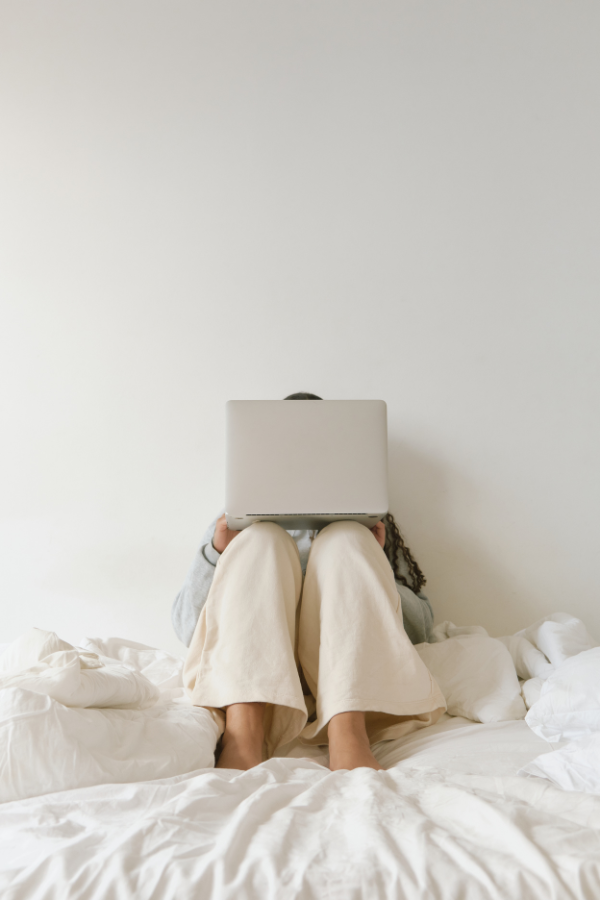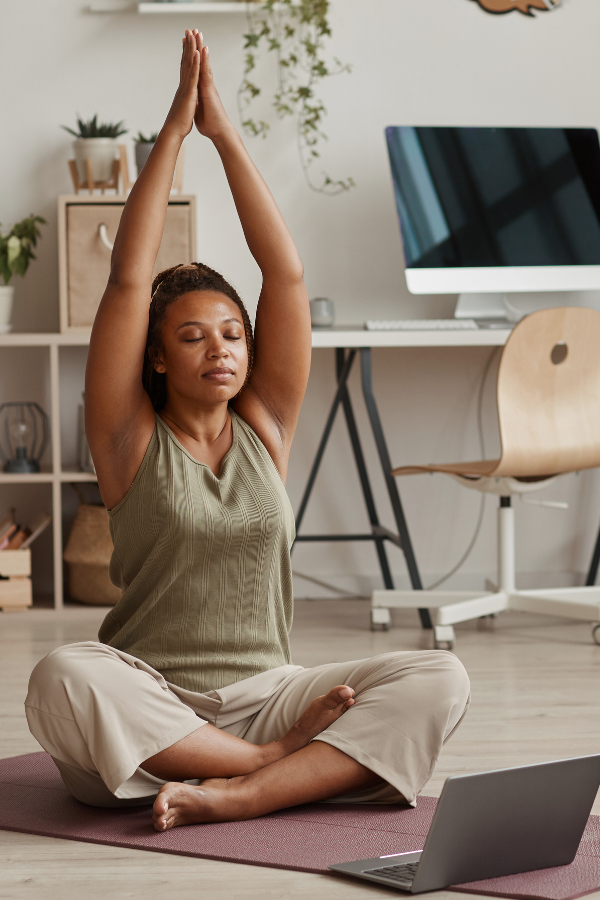

Body and Brain: Is Working from Bed Bad for You?
Summary
Working from bed might feel cozy, but it can negatively impact your sleep, posture, and mental well-being. While sometimes necessary, it’s essential to be mindful of these effects and make your workspace as ergonomic and healthy as possible. Creating clear boundaries between work and rest, incorporating movement, and practicing mindfulness can help maintain your overall health and productivity.
Reflection Questions
- How often do you find yourself working from bed, and what prompts you to do so?
- What steps can you take to improve your work-from-home setup to better support your physical and mental health?
- How can you create clearer boundaries between your work and relaxation spaces to enhance your well-being?
Journal Prompt
Reflect on your current work-from-home routine. Do you find yourself frequently working from bed? Write about how this habit impacts your sleep, posture, and mental state, and brainstorm ways you could create a more ergonomic and productive workspace. Consider setting goals for healthier work habits moving forward.
We’ve all been there—after a long day or a restless night, the thought of grabbing your laptop and working from the comfort of your bed can be incredibly tempting. Whether it’s sneaking in a few emails under the covers or spending the afternoon tackling tasks in your coziest pajamas, working from bed has become a common habit, especially with the rise of remote work. But have you ever wondered if this cozy setup is actually good for you? It’s essential to understand how working from bed might affect your mental, emotional, and physical well-being. In this article, we’ll dive into what the experts say about working from bed and share tips on making it a little healthier when you can’t resist.
But First…Is It Bad to Work from Bed?


Unfortunately, yes. As Bryan Lufkin writes in this article for the BBC, “But the reality is that turning your bed into your office can trigger a slew of health problems, both psychological and physical.” Lufkin notes that many issues related to working from bed are acute, but some “could be permanent!” But how bad is it actually, and why does working from bed have so many ill effects? Let’s take a closer look.
Sleep Hygiene and Bed Association


According to this resource from the Cleveland Clinic, “working from your bed could disrupt your sleep schedule and actually make you less productive.” We all know how important a good night’s sleep is, yet when you start turning your bed into an office, you might be compromising your sleep without even realizing it.
Sleep hygiene experts warn that when you use your bed for work, your brain can start to associate it with productivity rather than rest. This blurring of lines between rest and work can mess with your sleep cycle, potentially leading to insomnia or restless nights. It’s like trying to sleep in your office—it just doesn’t feel right, does it?
Postural Issues


Let’s face it, beds are great for lounging, not for maintaining good posture. When you work from bed, you’re likely to find yourself slouching or propping yourself up in awkward positions that can strain your neck, back, and shoulders.
Over time, this can lead to chronic pain and other musculoskeletal problems. Experts point out that poor posture, especially when working from a soft surface like a bed, can have long-term physical consequences that might not seem obvious right away but can add up over time.
Mental and Emotional Impact


While working from bed can feel like a cozy escape, it can also lead to feelings of lethargy and a lack of motivation. The comfort of your bed can make it harder to get into a productive mindset, which can leave you feeling emotionally drained by the end of the day.
There’s also evidence that working from bed might contribute to anxiety or depression, as the lack of physical separation between work and rest can make it harder to unwind and mentally disconnect from work.
Psychological Comfort vs. Long-Term Effects


Sure, working from bed can feel incredibly comforting—especially when you’re under the weather or just need a break from the desk. In the short term, it’s a great way to ease into your day or take care of yourself when you’re not feeling 100%.
However, it’s important to recognize that while this might feel good in the moment, regularly working from bed can have long-term negative effects on your overall well-being. Over time, the physical strain, mental fatigue, and disrupted sleep can take a toll, making it worth considering other, healthier ways to stay comfortable and productive.
What’s the Healthiest Way to Work from Home?
At An Ergonomic Workspace


Creating a dedicated, ergonomic workspace is crucial for your comfort and productivity. Start with a chair that offers good lumbar support to protect your lower back, keeping your spine aligned. Your feet should be flat on the floor, with your knees at a 90-degree angle, ensuring proper circulation and posture.
Position your monitor at eye level to prevent neck strain—if it’s too low, use a monitor stand or a stack of books to raise it up. Your keyboard and mouse should be at a height where your elbows are close to your body, and your wrists are straight to avoid strain.
Consider investing in a standing desk or a walking pad to add variety to your day. These options allow you to alternate between sitting, standing, and even walking while you work, which can significantly reduce the physical discomfort associated with long periods of sitting.
With Lots of Natural Light and Ventilation
Your workspace environment plays a big role in how you feel throughout the day. Position your desk near a window to take advantage of natural light, which not only boosts your mood but also helps regulate your circadian rhythm, leading to better sleep at night.
If natural light isn’t an option, consider using a daylight lamp to mimic the benefits of sunlight. Ventilation is equally important—stale air can lead to fatigue and reduced concentration. Ensure your workspace is well-ventilated by opening windows or using a fan or air purifier to keep the air fresh and oxygenated. This simple step can help keep your energy levels up and your mind sharp.
While Maintaining Clear Work-Life Boundaries
One of the biggest challenges of working from home is maintaining clear boundaries between work and personal life. It’s easy to let work spill over into your relaxation time when your workspace is just a few steps away from your living space.
To prevent this, establish specific work hours and stick to them. When your workday is over, close your laptop, turn off notifications, and shift your focus to personal time. Avoid working from spaces like your bed or couch, which should be reserved for relaxation. Creating distinct physical and mental boundaries between work and rest will help you unwind more easily and keep burnout at bay.
And Incorporating Regular Movement and Breaks


Sitting for long periods can take a toll on your body, leading to stiffness, back pain, and decreased energy. To counteract these effects, it’s important to incorporate regular movement into your day. Consider using a standing desk to alternate between sitting and standing throughout your workday, or add a walking pad under your desk to get some steps in while you work.
If these aren’t options, make a habit of taking short breaks every 30 minutes to stretch, walk around, or do a quick exercise. These small, frequent movements can help improve circulation, prevent muscle stiffness, and keep you feeling more energized and focused.
Fuel your creative fire & be a part of a supportive community that values how you love to live.
subscribe to our newsletter
*please check your Spam folder for the latest DesignDash Magazine issue immediately after subscription


And Practicing Mindfulness and Stress Management
Working from home can blur the lines between work and personal time, making it easy for stress to build up. To keep your mental and emotional wellness in check, it’s important to incorporate mindfulness practices into your routine. Start your day with a few minutes of deep breathing or meditation to set a calm tone for the day ahead.
Throughout the day, take short breaks to practice mindfulness—whether it’s focusing on your breath, doing a quick body scan, or simply stepping outside to clear your mind. These practices can help you stay centered, manage stress more effectively, and maintain a healthier work-life balance.
What About When You Have to Work from Bed? Tips for Making WFB Healthier


Sometimes, working from bed isn’t just a cozy choice—it’s a necessity. If you’re recovering from surgery or dealing with an injury, getting out of bed and setting up at a desk might not be possible. In these cases, your bed becomes your command center, and that’s perfectly okay. The key is to listen to your body and prioritize your recovery, even if that means temporarily turning your bedroom into a workspace.
When you’re facing mental health challenges like depression or severe anxiety, the idea of getting out of bed might feel overwhelming. On days when even the most minor tasks seem daunting, working from bed can be a lifeline, allowing you to stay productive without the added stress of moving to another room. It’s important to be gentle with yourself during these times and recognize that doing what you can from bed is still an accomplishment.
Living with chronic illness or extreme fatigue can make the simplest tasks feel exhausting. Working from bed might be the only viable option on days when your energy levels are low or mobility is limited. In these situations, it’s about finding ways to make yourself as comfortable as possible while still getting things done. Your bed becomes more than just a place to rest—it’s your refuge, and your workspace all rolled into one.
Below are a few tips for healthier bed-based work when it can’t be avoided.
Make It More Ergonomic


If you’re going to work from bed, you might as well do it in a way that’s kinder to your body. Start by stacking a few firm pillows behind your back for support and to keep your spine aligned. A laptop stand can do wonders for bringing your screen up to eye level, which helps prevent neck strain.
And if you can, use a tray table to keep your laptop and other essentials at a comfortable height, so you’re not hunching over. It’s all about creating a setup that feels supportive and keeps you from slouching too much.
Take Breaks and Move Around If Possible


Even when you’re working from bed, it’s crucial to take regular breaks to stretch and move around. Set a timer to remind yourself to get up every hour—do a few gentle stretches, walk around your room, or even step outside for some fresh air. These small movements can make a big difference in preventing stiffness and keeping your energy levels up throughout the day.
Employ Mental Separation Techniques


One of the challenges of working from bed is keeping a clear boundary between work time and rest time. To help with this, try changing positions during the day—sit up straight when working, and then lie down when it’s time to relax. You might also consider altering your bedding slightly, like adding a throw blanket or different pillows, to signal a shift from work mode to rest mode. Setting up a small “work zone” in bed, like a specific corner where you always sit, can also help create that mental separation.
Optimize Lighting and Your General Environment


Good lighting is key to reducing eye strain and boosting your mood while working from bed. If possible, position yourself near a window for natural light, or use a soft, adjustable lamp to brighten up your space. Make sure your room is well-ventilated—fresh air can do wonders for your focus and energy. And to minimize distractions, keep your workspace tidy and free from clutter, so you can stay in the zone without being tempted by everything else going on in your room.
Final Thoughts on WFB (We Get the Appeal)


At the end of the day, working from bed might feel cozy and convenient, but it’s important to recognize the potential downsides, from poor posture to disrupted sleep and decreased motivation. Creating a healthier work environment, whether that means setting up an ergonomic desk or finding ways to move more throughout the day, can make a big difference in how you feel both physically and mentally.
While it’s totally okay to work from bed occasionally—especially when life demands it—remember that your well-being deserves thoughtful choices. Strive for a setup that supports your long-term health and happiness, and you’ll find yourself feeling better and more productive in the long run.








